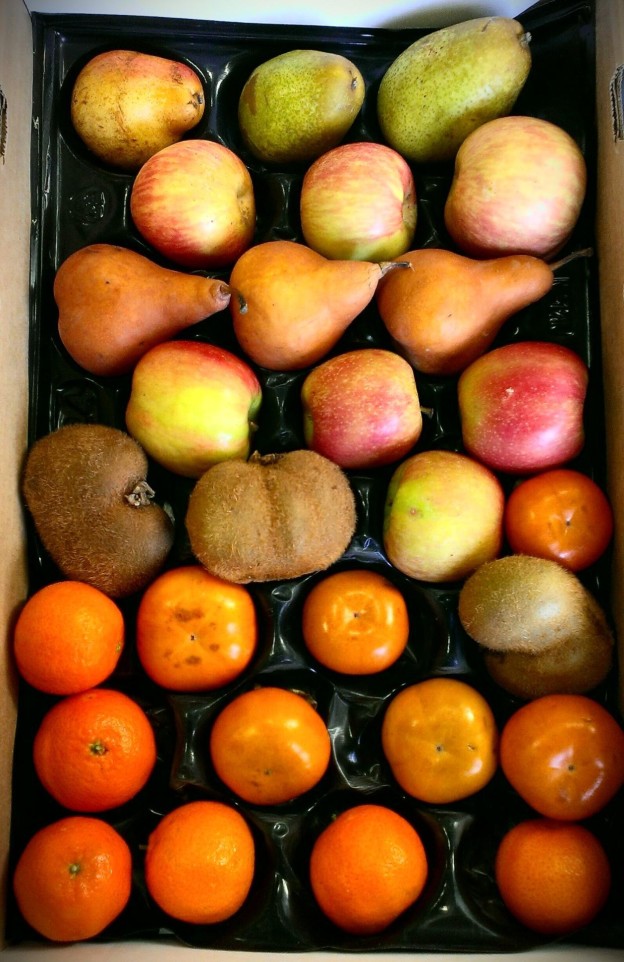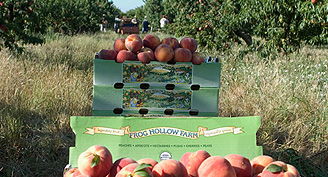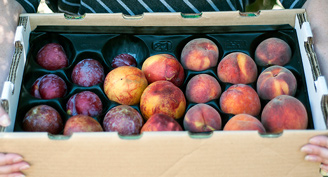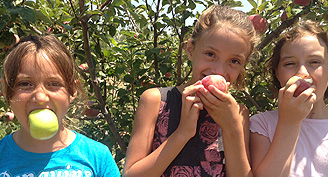THIS WEEK’S FRUIT
 Pink Lady Apples
A cross between the Golden Delicious and Lady Williams, the Pink Lady is a crisp and juicy apple with a tart finish. Pink skins and a creamy white colored flesh that resists browning makes, this an excellent apple for salads and slicing. Store on your counter out of direct light for 4-5 days. Refrigerate after to maintain crispness.
Warren Pears
This pear has a classic European texture, very soft and juicy with a silky sweetness that avoids the typical grittiness found in most pears. Pears are ripe when wrinkled and yielding slightly near the stem. Pears will store well in the fridge once they have reached your optimal ripeness.
Fuyu Persimmon
Twin Girls, Yettem, CA
The Fuyu has a crisp texture and delicate sweet flavor. They have a beautiful orange to red hue when ripe. They can be eaten out of hand with skin on or peeled. Store on the counter for 3-5 days or refrigerate for longer enjoyment.
Hayward Kiwi
Chieci Farm, Live Oak, CA
Originally known as the Chinese gooseberry due to its Chinese orgins. Hawyward Wright, a New Zealand nurseryman propagated his plants by grafting and they eventually became the preferred cultivar of growers due to their sweet flavor and thin skin.Ready to eat when they yield to gentle pressure. Store these on the counter for 4-5 days. Refrigerate for up to two weeks.
Fuji Apples
Cayuma Orchards, New Cayuma, CA
Fujis are a cross between Red Delicious and Ralls Janet, an heirloom apple dating back to Thomas Jeffrson. Fujis are loved by many for their crisp, sweet, and juicy character. Store on your counter out of direct light for 4-5 days. Refrigerate after to maintain crispness.
Golden Russet Bosc Pears
The Golden Russet is true to its name with a yellowish-white flesh and a uniformly russet skin. It has the classic Bosc shape of a long elegant neck. Excellent for cooking with, the Bosc’s texture holds up very well in pies, tarts, and for poaching. Pears will store well in the fridge once they have reached your optimal ripeness.
Clementine Mandarins
Olsen Organic Farm, Lindsay, CA
Clementines are very sweet, juicy, easy to peel, and usually seedless, making them very popular with chil-dren and adults alike. Store out of sunlight for 2-4 days on the counter or up to two weeks in the fridge.
Pink Lady Apples
A cross between the Golden Delicious and Lady Williams, the Pink Lady is a crisp and juicy apple with a tart finish. Pink skins and a creamy white colored flesh that resists browning makes, this an excellent apple for salads and slicing. Store on your counter out of direct light for 4-5 days. Refrigerate after to maintain crispness.
Warren Pears
This pear has a classic European texture, very soft and juicy with a silky sweetness that avoids the typical grittiness found in most pears. Pears are ripe when wrinkled and yielding slightly near the stem. Pears will store well in the fridge once they have reached your optimal ripeness.
Fuyu Persimmon
Twin Girls, Yettem, CA
The Fuyu has a crisp texture and delicate sweet flavor. They have a beautiful orange to red hue when ripe. They can be eaten out of hand with skin on or peeled. Store on the counter for 3-5 days or refrigerate for longer enjoyment.
Hayward Kiwi
Chieci Farm, Live Oak, CA
Originally known as the Chinese gooseberry due to its Chinese orgins. Hawyward Wright, a New Zealand nurseryman propagated his plants by grafting and they eventually became the preferred cultivar of growers due to their sweet flavor and thin skin.Ready to eat when they yield to gentle pressure. Store these on the counter for 4-5 days. Refrigerate for up to two weeks.
Fuji Apples
Cayuma Orchards, New Cayuma, CA
Fujis are a cross between Red Delicious and Ralls Janet, an heirloom apple dating back to Thomas Jeffrson. Fujis are loved by many for their crisp, sweet, and juicy character. Store on your counter out of direct light for 4-5 days. Refrigerate after to maintain crispness.
Golden Russet Bosc Pears
The Golden Russet is true to its name with a yellowish-white flesh and a uniformly russet skin. It has the classic Bosc shape of a long elegant neck. Excellent for cooking with, the Bosc’s texture holds up very well in pies, tarts, and for poaching. Pears will store well in the fridge once they have reached your optimal ripeness.
Clementine Mandarins
Olsen Organic Farm, Lindsay, CA
Clementines are very sweet, juicy, easy to peel, and usually seedless, making them very popular with chil-dren and adults alike. Store out of sunlight for 2-4 days on the counter or up to two weeks in the fridge.
A NOTE FROM AL
Counting the Hours Dear CSA Members,As 2013 comes to a close, we farmers begin to think about next year by counting down the “chill hours”until the New Year. Chill hours are defined as the hours between 45 degrees and 32 degrees occurring during November 1st and Febru- ary 28th . The number of chill hours during this time of the year dictates what the quality of the fruit will be at their peak ripeness. Cold hours help break dormancy and let the tree resume growth in the warm spring.
During the fall season, the shorter, cooler days stimulate growth inhibitor hor- mones that stop the trees from growing. The winter months break the standstill in growth by the cold temperatures by disabling growth inhibitor hormones. We wait for a 45 degree temperature to break the dormancy.
Nature is on perfect clockwork and we can see with our eyes the amazing effects of the natural processes. When the right numbers of chill hours have been met on the farm, and as longer and warmer days progress, the natural growth processes will begin again. With insufficient chill, trees can leaf out late in the season, blos- soms may be prolonged, buds may deteriorate and/or drop and a few, if any, flow- ers are produced and without flowers – there is no fruit.
The need for chill varies from fruit to fruit; cherries need the most, +/- 1000 hours of cumulative chill hours, which in Brentwood is about the most we’ve gotten in the last 10 years. Our peaches are good with 500-600 hours, which we can always count on. In fact, everything that we grow here is well adapted to the historical conditions in Brentwood.
So the countdown begins! One month of winter chill is now complete, and as of November 30th, we have accumulated 130 hours. Not a bad start compared with the last 7 years. Better than last year at this time but behind the three previous years. We are hoping for a cold snap to build up our winter chill to our comfort zone.
The bigger concern is the effects of global warming and climate change. Over the last several years we’ve noticed a lessening of winter chill, and our cherry crops are the “canary in the coal mine”, their lighter crops of recent years perhaps signaling a sea change in this most critical requirement of fruit production in California.
Is there anything we can do about it? I like to think there is and we are doing it…building up the soil biologically with compost, compost tea and vermicompost; growing cover crops; building up the soil organic matter. All this is aimed at providing the tree with opportunity to adapt to change, by giving the tree a soil ecology which maximizes their health and increases their resilience to stress. We believe that our biological approach to soil fertility will also reduce the “carbon footprint” of Frog Hollow Farm, thereby adding our small contribution to worldwide efforts to reduce global warming.
Meanwhile, we’re also very much in need of rain, 2013 being the driest year statewide in California since they began keeping records of rainfall in the 1800’s. Usually, rainy weather is not cold. So, we’re stuck in a catch-22; wishing for one at the possible expense of the other. Rain and cold, we need them both and soon!






